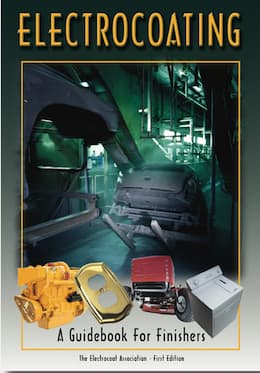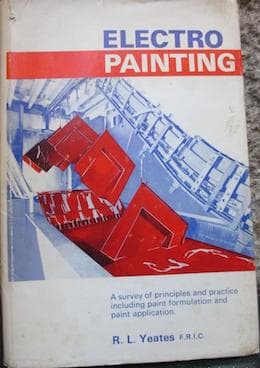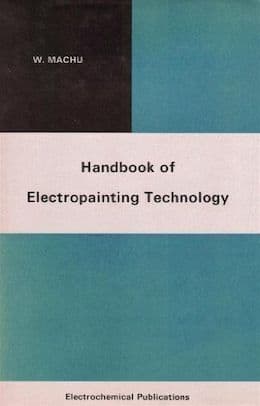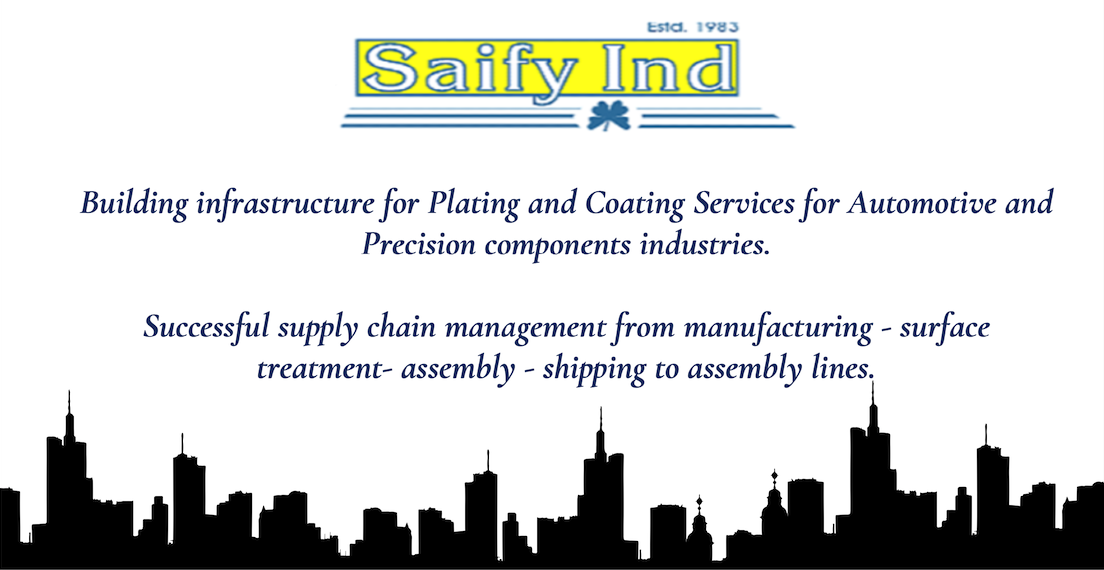
-----
Electrodeposition/e-coating
Anolyte, Ultrafiltration, Constituents, Bacterial Growth
Quickstart:
CED is an acronym for Cathodic Electro Deposition, i.e., electrocoating or electropainting where the work is cathodic. The anodes are in in a compartment separated from the rest of the solution by semi-permeable membranes; the solution in the anode compartment is called "anolyte".
This thread focuses on Q&As and problems & solutions believed to primarily relate to the electrolyte, the "paint" itself.
Q. I am working in German MNC as supplier Quality head. we are facing issues in the coating quality specifically on the surface of the weld material used to join two parts. The area is not getting covered during CED coating. ⇐ answer?
Dinesh Pethesupplier Quality Head - Pune
November 9, 2024
Ed. note: Hi Dinesh. This particular thread focuses mainly on possible issues with the paint itself --which is unlikely to be the cause of your problem. If you search the site for "ced weld" you will find a good deal of info about your particular problem. Good luck.
Q. I am currently facing an issue of CED rupture and pinholes in my coating process. I have checked and confirmed that all my bath parameters are within the recommended limits. Additionally, I am using an SCR rectifier with a 14 anode cell at 360 volts only, but the rupture and pinhole defects are still occurring.
jayeshemployee - pune
September 20, 2025
Tip: Readers are welcome to browse this site anonymously!
But its main purpose is to build worldwide camaraderie through sharing.
Those who believe in this might not engage with anonymous posters.
⇩ Related postings, oldest first ⇩
for Shops, Specifiers, & Engineers

avail from eBay, AbeBooks, or Amazon

avail from eBay, AbeBooks, or Amazon

avail from AbeBooks, or Amazon

avail from eBay, AbeBooks, or Amazon

avail from eBay, AbeBooks, or Amazon
(as an Amazon Associate & eBay Partner, we earn from qualifying purchases)
Q. Shall I add any of the following chemicals in the anolyte tank to reduce the Bacterial growth in E.coat process?
1. Silver Nitrate
⇦ on
eBay or
Amazon [affil link]
2. 5-Chloro 2-methyl-4-Isothiazolin-3-one
3. Hydrogen Peroxide 33% ⇦ on
eBay or
Amazon [affil link]
4. or shall I put U.V sterilizer in the D.M water line ⇦ on
eBay or
Amazon [affil link]
to control bacteria?
Can you tell me best method to sort out the issue?
wheels - Chennai, Tamil nadu, India
2005
A. Before adding any chemicals you should seek the advice of your paint supplier.
The simplest way is to add Hydrogen peroxide ⇦ on
eBay or
Amazon [affil link]
and circulate for a few hours before draining the entire anolyte and refilling with fresh. Hydrogen peroxide will break down into water and nascent oxygen and will not be a threat to the paint bath.
Thereafter keep a close watch on the pH and maintain in within the range specified by the paint supplier.
Mohali, Punjab, India
Q. We are leading automotive wheel manufactured in India. Recently we are facing the following problem in our process plant. The problem was heavy algae formation in the anolyte solution. For that we are taking the following measures.
1. Sent the algae to biological lab for test to know what type of algae.
2. Sent query to anode supplier for compatible in between anolyte and electrode membrane
3. How frequency it is growth
4. Sent query to chemical supplier.
During study we observed the algae formation started when the fresh solution preparation after 52 hrs circulation.
Anolyte flow rate drastically declined during this period from 2 lit/min to 0.5 lit /min
Lab study shows the algae not water based it is sulphate reduced type algae.
UV sterilized only will kill water based algae only.
For that now we are doing instead of 7 days once cleaning the tank we reduced the frequency of 3 days.
I request to know more about to avoid the algae formation in the anolyte solution please sent suitable technical solution.
⇐ answer?
- CHENNAI, TAMILNADU, INDIA
2006
Fungus is growing in anolyte compartment of CED bath
Q. Dear sir,
In my acrylic CED bath, the anolyte solution is continuously recirculated, in which I am maintaining pH <3 and conductivity >300 and <5500 for anolyte solution as per the acrylic resin product supplier specification. While bath ages, conductivity increases slowly and pH decreases correspondingly. Due to acidic pH, fungus are forming in the anolyte tank which leads to flowmeter and pipe line through which anolyte solution passing is blocked after few days. From your site I came to know that maintaining the anolyte conductivity in higher range will reduce the fungus formation.
1. Really it is true (high conductivity will reduce the fungus formation)?
2. If so, how to increase the conductivity of anolyte solution.
- Mumbai, India
2006
A. Install a conductivity controller and sensor. This will maintain conductivity near a desired set-point by activating a fresh DI water valve.
Dan Mack- Horicon, Wisconsin
July 10, 2013
Q. DI WATER WILL REDUCE THE CONDUCTIVITY OF SOLUTION SINCE IT HAS A CONDUCTIVITY OF LESS THAN 10. HOW IT WILL CONTROL ANOLYTE CONDUCTIVITY TO HIGHER SIDE?
ROHIT JAIN- FARIDABAD, India
August 17, 2023
A. Hi ROHIT,
I think you are misreading this posting, or at least its implications :-)
Ravichandran said that his conductivity was increasing and he needed to reduce it -- but he needs to be careful to not reduce it too much for fear of biological growth. Dan suggested using a conductivity controller to keep it from rising above a set level.
If you have a problem of your own, please explain the problem or situation. Thanks!
Luck & Regards,

Ted Mooney, P.E. RET
Striving to live Aloha
finishing.com - Pine Beach, New Jersey
Ted is available for instant help
or longer-term assistance.
Throwing power of CED paint
Q. In CED painting how we measure throwing power of CED Paint by 4 box section method? ⇐ answer?
Jazeel Siddiquipaint consultant and supplier - Pakistan
February 13, 2009
Q. What is anolyte, theory of ultra filtration for ED paint, constituents of ED paint? -- because I am doing work In CED line.
Liaqat BashirAutomotive - Tehran, Iran
April 24, 2009
A. Anolyte is a solution of DI water and an acid. The pH and conductivity of this is specified by the E-coat paint supplier. The acid to be added is normally called pH controller and is also supplied by the E-coat paint supplier. The function of anolyte is to conduct the charge from the anode to the paint and to carry away the acid generated in the anode cell into the anolyte reservoir.
The theory of ultrafiltration is much like the function of the kidney in the human body. The UF membrane removes water along with solvent and solubilizer from the E-coat bath and this solution is called permeate. The permeate is recycled back into the E-coat bath after utilizing it for paint recovery. If it is drained it leads to unbalance of solvent and solubilizer in the bath as well as the permeate tanks.
The constituents of ED paint is not part of public domain and will be covered under IPR. That in any case is not useful information for a user.
Mohali, Punjab, India
A. In addition to Mr Gurvin
E coat Paint is combination of D.I Water _ 85% + Emulsion + Paste _13% (Mainly Black, Grey primer)+ Solvent 2%.
- DELHI, INDIA
What is the major function of anode cells in CED?
Q. Please anyone explain what is major functions of anode cells in CED bath?
vinodh Balu- Chennai, TN, INDIA
January 21, 2015
A. Hi Vinodh. I don't know a lot about ED, but the major function of the anode cells is to complete the circuit since the work is the cathode :-)
Gurvin's explanation of the anolyte and ultrafiltration explains the situation a bit further.
Regards,

Ted Mooney, P.E.
Striving to live Aloha
finishing.com - Pine Beach, New Jersey
Ted is available for instant help
or longer-term assistance.
Can't get electrocoating voltage high enough
Q. Dear Experts,
Currently I'm facing voltage drop for my ED paint Anolyte Membrane.
Voltage using is 240 VDC to 350 VDC.
When testing without the load, it can reach the voltage that I set. But with load it can reach only 290 VDC even I set at Max side.
I suspect maybe our RECTIFIER is having a problem; please give advice on this matter.
One more thing, can anyone share the correct method to check whether Anolyte membrane Cell is Okay or NG?
⇐ answer?
- KUALA LUMPUR, MALAYSIA
February 3, 2016
Q. HELLO SIR,
I AM A PLANT SUPPLIER.
I WANT TO KNOW HOW MUCH QTY OF BACTERIA IN ANOLYTE IS GOOD, AND WHAT CAN REMOVE IT? ONLY UV LIGHT, ANY OTHER OPTION? PLEASE CONFIRM.
IF ANODE CELL INTERNAL LEAKAGE, HOW CAN I KNOW BECAUSE WE ARE USING FREE RETURN LINE.
PAINT SHOP SUPPLIER - PUNE MAHARASTRA INDIA
August 18, 2017
A. Check with your paint supplier about using a small amount of biocide in the anolyte. Once you have bacteria, it needs to be mechanically removed (brushes, hosed out, etc.) You will know it when you have it because it resembles cabbage in the return tubes.
You can check for internal leaks by shutting off the anolyte pump and closing the supply and return for each membrane. The anolyte level in the leaking membranes will equalize with the level in the paint tank.
- Horicon, Wisconsin
DI Water solution and Quality in E-Coating
Q. Hi ... I'm new to this and put into the deep end at my work place, concerning the e-coat line.
What is the water called, DI or DIY?
I know acids Hydrochloric Acid and Caustic must be added and the conductivity must be at a certain level. To get to the desired/acquired quality of DIY water.
⇐ answer?
Handyman / Maintenance - Port Elizabeth, South Africa.
October 9, 2017
How to heat E-coat tank for single shift operation?
Q. I'm having problems with keeping the e-coat tank warm. We are only running one shift so the e-coat does not run during the night shift. What can I does to keep the temperature up?
Mark Grajewski- Dayton Ohio
November 9, 2017
A. Mark Grajewski,
You must be having chiller to keep the temperature of paint in required limit. Just raise the temperature of the chiller and your problem is solved.
- Nashik, Maharashtra, INDIA
Q. Dear Sir,
I am a plant manager of a CED plant. Right now, because of our supplier's mistake, we are facing the problem of UF membrane choking. One Outside Auditor came for the audit and he has suggested piping changes in CED ... that can take time.
Because of this problem I am not able to add more paint in my bath and there is much less paint there; and our pH value is about 4.5 only (which should be min 5.8 as per our paint supplier).
What should I do to increase pH? ⇐ answer?
Viren Khuntpumps - Rajkot,Gujarat, India
January 27, 2018
Q. I operate a large cathodic epoxy e-coating process coupled with a powder shop. We specialize in painting cooling fins on large transformers (grid size). The fins can be 300 mm deep and only say 10 mm wide. while coating the whole outside is simple and cheap I am curious to know why the e-coat doesn't coat the inside of the fin too. I know it is about Throwing Power but none of my "experiments" have had any success. I am guessing the physics of the set up is against me and that the necessary Throwing power quickly gets exponential for what I am trying to achieve. Any ideas? ⇐ answer?
Jimmy GanlyPaint shop at Large Transformer producer - Cavan, Ulster, Ireland
April 11, 2018
Q. Hello expert, I work in a CED paint shop. I need to know why current is not passing through the ED tank circulation pump.
Paint is charged by Anode cell and conveyor having Negative charge. Its circuit being completed through process parts.
But no current is available in pipe lines or tanks. So what is the Fundamentals?
Please explain it to me.
Thanks
VOITH INDUSTRIAL SERVICES INDIA PVT LTD - Aurangabad, Maharashtra, India
May 4, 2018
A. Ambrish Dwivedi
The conductivity of CED bath is very low, hence it requires 200-250 volts to flow the current.
The volume which flows through the pipe is so less as compared to tank volume that the voltage doesn't reach to the pipeline. Hence we do not get any current where you are expecting.
- Nashik, Maharashtra, INDIA
July 13, 2018
⇦ Tip: Readers want to learn from your situation;
so some readers skip abstract questions.
Q. Hi, Thanks for explanation, Avinash. Can you explain a little more. If there is movement of current in bath but it is FRP coated but pipelines are not, why is there no current.
Jinendra Gupta- Vadodara
November 23, 2023
A. Hi Jinendra. We'll try to notify Avinash of your question, but his posting was from 5 years ago.
Are you asking why you don't get coverage inside a pipe or tube? As Avinash says, the conductivity of the electrolyte is very low, i.e., the resistivity is very high ...
Current [which is necessary for deposition to occur] = Voltage / Resistance, and
Resistance = Resistivity X Length / Area of pipe
So it isn't realistic to expect that at reasonable voltages a long length of solution of small cross sectional area can carry enough current for deposition.
Apologies if that is not what you were asking, but if it wasn't, then please state your own situation and problem for Avinash or other readers to respond to, including the diameter of the pipe, and how far in coverage stops. Thanks!
Luck & Regards,

Ted Mooney, P.E. RET
Striving to live Aloha
finishing.com - Pine Beach, New Jersey
Ted is available for instant help
or longer-term assistance.
Fouling of Anode Electro Deposition System
Q. My situation: RO system permeate tank got filled with some fungus because of not using it for a long time. Is it really fungus? It choked pipeline which carries permeate to rinse tanks
Kasi Viswanath Boddeti- India
July 12, 2018
A. Fouling of Anode Electro Deposition System.
It is fungus. Clean the tank every time before use.
The fungus does develop after certain period.
- Nashik, Maharashtra, INDIA
![]() Thanks for your three excellent answers here Avinash!
Thanks for your three excellent answers here Avinash!
Regards,

Ted Mooney, P.E. RET
Striving to live Aloha
finishing.com - Pine Beach, New Jersey
Ted is available for instant help
or longer-term assistance.
Q1. We are running CED. Sir, actually the membrane of anode cell is torn, so it can be applicable to use in CED? Because our product is not going to be ok.
When we circulate the DM water, it passes thorough anode cell and get it back in to the bath, will it affect the result?
Coating ind - Vadodara, Gujarat, India
August 14, 2019
Q2. We manage all the parameters for CED. But we have face shining problem on the coated job. What should we do, please guide us.
Nilofar Vohra [returning]Coating ind - Vadodara, Gujarat, India
September 25, 2019
Q3. Sir, we are running CED bath. We are new. CED coated object shows wrinkles. What are the the causes for this problem?
Nilofar Vohra [returning]Coating ind - Vadodara, Gujarat, India
September 25, 2019
? Hi Nilofar. Did you replace that torn membrane? Can you please send some photos to mooney@finishing.com for posting here? We have hundreds of Q & A's about CED problems on this site, but I see nothing about "shining" or "face shining" and we don't want to misunderstand. Are you saying that you are applying a matte CED coating and the reflectivity is too high? Too high compared to what: Is it just an occasional part? Is it one particular area on every part?
If you are just starting and have no hands-on experience it can be tough. You may want to contact the paint vendor, the system supplier, or a CED consultant to help you get started. Best of luck!
Regards,

Ted Mooney, P.E. RET
Striving to live Aloha
finishing.com - Pine Beach, New Jersey
Ted is available for instant help
or longer-term assistance.
![]() Dear Ted,
Dear Ted,
A very good answer to such question.
- Nashik,Maharashtra, India.
September 7, 2023
This string of questions demonstrates that the posters know a lot about the subject and could help others!
As people show interest in each other's situations, the page quickly becomes an informative learning experience for all of us! 🙂
But when people don't engage with their peers and offer help, and try to use the forum as a free consulting service -- taking but not giving, dropping off a question as they cruise by -- no one's questions get answered so they're just wasting their time as well as bleeding the resource.
Please try to help others!
Q. Sir how to choose the pump for CED Paint circulation? What's the requirements for choosing that? ⇐ answer?
Mano harKesm India LLP - Cuddalore, Tamilnadu, India
October 9, 2019
Q. Hi, please advise on respective problem. Currently we can observe biofilm growth in our anolyte system. Suspected bacteria growth in ED system, which enter our anode membrane and cause anolyte overflow into bath. This results in pH drop within the system. Is there any effective way to solve this problem? currently we are adding in biocide every week, but not effective enough to solve. Thank you. ⇐ answer?
Jayakumar ponniasalanecoating - Selangor malaysia
January 16, 2020
Q. Hey,
I have a question and I tried to search a lot for it
We have in our company electrophoretic technology Polyurethane,
We have solvent which come with the lacquer from the same company
Now the company bring a new solvent.
There no difference between them in the experiment
But analysis of contamination for the new one finds that
Iron 2.6 mg/l
Copper 0.37 mg/l
Zinc 1.44
Our Solvent.. Old one
Iron 1.1 mg/l
Copper 0.06 mg/l
Zinc 1.1 mg/l
I want to know does this difference in the impurities make difference in the work?
What is the range of metallic contamination?
Thanks in advance.
⇐ answer?
Asfour Crystal - shobra elkhima, Egypt
March 2, 2020
Q. I want to thank you for your time and information.
I have a question about e-coating ( polyurethane)
What is the range of metallic impurities that we have to agree on the solvent we use.
Like I have now two companies with 2 Solvent
After the metallic analysis
The first one :
Iron 2.6 mg/l
Copper 0.37 mg/l
Zinc : 1.44 mg/l
The second one :
Iron 1.1 mg/l
Copper 0.06 mg/l
Zinc 1.1 mg/l
The first one is more cheaper than the other
So can you please tell me a range of metallic impurities for the solvent to be used.
⇐ answer?
Asfour Crystal - shobra elkhima, Egypt
March 2, 2020
Q. ED PAINT IS NOT CIRCULATING THROUGH BAG FILTERS. INLET PRESSURE 3.5 KG AND OUTLET SHOWING 0 KG AFTER REPLACEMENT OF NEW FILTERS. PROBLEM OCCURRED AFTER 50-DAY LOCKDOWN AND RESIDUE CHECKED; FOUND 400 MG/LIT.
KINDLY SUGGEST AND ADVISE; CURRENTLY WE ARE CIRCULATING PAINT THROUGH STRAINERS ONLY.
⇐ answer?
- Aurangabad Maharashtra
May 30, 2020
for Shops, Specifiers, & Engineers

avail from eBay, AbeBooks, or Amazon

avail from eBay, AbeBooks, or Amazon

avail from AbeBooks, or Amazon

avail from eBay, AbeBooks, or Amazon

avail from eBay, AbeBooks, or Amazon
(as an Amazon Associate & eBay Partner, we earn from qualifying purchases)
Q. Sir Good morning,
We are facing of Bend test failure after CED painting; kindly suggest major reason of failure of bend test.
Thanks.
- Gurgaon Hariyana, India
October 11, 2020
A. Hi Raj. The reason for failure is either insufficient adhesion or (probably less likely) brittleness of the coating. Can you tell us the details of the bend test you failed, what kind of pretreatment you do, and what kind of paint you are applying? Only rarely can either a medical practitioner or a CED practitioner or anyone else do a diagnosis from one single symptom; we probably need more info. Is this a new installation that has not yet produced satisfactory work, or a long-established one which only recently developed this new problem? Thanks.
Luck & Regards,

Ted Mooney, P.E. RET
Striving to live Aloha
finishing.com - Pine Beach, New Jersey
Ted is available for instant help
or longer-term assistance.
Q, A, or Comment on THIS thread -or- Start a NEW Thread
